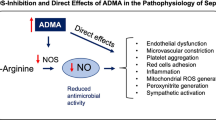Abstract
Purpose. Nitric oxide synthase (NOS) inhibitors such as Nitro-L-arginine (L-NA) are being considered for the management of hypotension observed in septic shock. However, little information is available regarding the pharmacokinetic and pharmacodynamic properties of these agents. Our objective was to examine the relationships between L-NA plasma concentration and various hemodynamic effects such as cardiac index (CI), mean arterial pressure (MAP), and heart rate (HR) elicited by L-NA administration in rats.
Methods. L-NA was infused at doses between 2.5 − 20 mg/kg/hr in anesthetized rats over one hour. Hemodynamic effects and plasma L-NA levels were determined.
Results. Infusion of L-NA resulted in dose-dependent increases in MAP and systemic vascular resistance (SVR), decreases in CI, and minimal change in HR. The relationships between the hemodynamic effects and plasma L-NA levels were not monotonic, and hysteresis was observed. Using nonparametric analysis, the equilibration half-time (t1/2,keo) between plasma L-NA and the hypothetical effect site was determined to be 51.5 ± 6.6 min, 42.4 ± 10.1 min, 43.4 ± 9.0 min for MAP, CI, and SVR, respectively (n = 14). The Emax and EC50 values obtained were + 32.5 ± 8.4 and 2.6 ± 1.3 μg/ml for MAP and −52.9 ± 15.6 and 3.7 ± 1.8 μg/ml for CI, respectively.
Conclusions. Although L-NA can bring about beneficial elevation of MAP, such effect is always accompanied by a stronger effect on CI depression. Dose escalation of L-NA may bring about detrimental negative inotropic effect and loss of therapeutic efficacy.
Similar content being viewed by others
REFERENCES
S. Moncada and E. A. Higgs. Molecular mechanisms and therapeutic strategies related to nitric oxide. FASEB J. 9:1319–30 (1995).
A. Petros, G. Lamb, A. Leone, S. Moncada, D. Bennett, and P. Vallance. Effects of a nitric oxide synthase inhibitor in humans with septic shock. Cardiovas. Res. 28:34–9 (1994).
J. A. Lorente, L. Landin, R. De Pablo, E. Renes, and D. Liste. L-arginine pathway in the sepsis syndrome. Crit. Care Med. 21:1287–95 (1993).
R. E. Klabunde, R. C. Ritger, and M. C. Helgren. Cardiovascular actions of inhibitors of endothelium-derived relaxing factor (nitric oxide) formation/release in anesthetized dogs. Eur. J. Pharmacol. 199:51–9 (1991).
R. G. Kilbourn, C. Szabo, and D. L. Traber. Beneficial versus detrimental effects of nitric oxide synthase inhibitors in circulatory shock: lessons learned from experimental and clinical studies. Shock 7:235–46 (1997).
E. A. Minnard, J. Shou, H. Naama, A. Cech, H. Gallagher, and J. M. Daly. Inhibition of nitric oxide synthesis is detrimental during endotoxemia. Arch. Surg. 129:142–7 (1994).
F. M. Robertson, P. J. Offner, D. P. Ciceri, W. K. Becker, and B. A. Pruitt, Jr. Detrimental hemodynamic effects of nitric oxide synthase inhibition in septic shock. Arch. Surg. 129:149–55 (1994).
M. A. Tabrizi-Fard and H. L. Fung. Reversed-phase high-performance liquid chromatography method for the analysis of nitroarginine in rat plasma and urine. J. Chromatog. B: Biom. Applica. 679:7–12 (1996).
D. Verotta and L. B. Sheiner. Simultaneous modeling of pharmacokinetics and pharmacodynamics: an improved algorithm. CABIOS 3:345–9 (1987).
J. D. Unadkat, F. Bartha, and L. B. Sheiner. Simultaneous modeling of pharmacokinetics and pharmacodynamics with nonparametric kinetic and dynamic models. Clin. Pharmacol. Ther. 40:86–93 (1986).
L. B. Sheiner, D. R. Stanski, S. Vozeh, R. D. Miller, and J. Ham. Simultaneous modeling of pharmacokinetics and pharmacodynamics: application to d-tubocurarine. Clin. Pharmacol. Ther. 25:358–71 (1979).
W. G. Haynes, J. P. Noon, B. R. Walker, and D. J. Webb. Inhibition of nitric oxide synthesis increases blood pressure in healthy humans. J. Hypertension. 11:1375–80 (1993).
H. M. Vargas, J. M. Cuevas, L. J. Ignarro, and G. Chaudhuri. Comparison of the inhibitory potencies of N(G)-methyl-, N(G)-nitro-and N(G)-amino-L-arginine on EDRF function in the rat: evidence for continuous basal EDRF release. Journal of Pharmacology & Experimental Therapeutics. 257:1208–15 (1991).
N. H. Holford and L. B. Sheiner. Understanding the dose-effect relationship: clinical application of pharmacokinetic-pharmacodynamic models. Clin. Pharmacokin. 6:429–53 (1981).
W. J. Jusko and H. C. Ko. Physiologic indirect response models characterize diverse types of pharmacodynamic effects. Clin. Pharmacol. Ther. 56:406–19 (1994).
P. Klatt, K. Schmidt, F. Brunner, and B. Mayer. Inhibitors of brain nitric oxide synthase. Binding kinetics, metabolism, and enzyme inactivation. J. Biol. Chem. 269:1674–80 (1994).
E. S. Furfine, M. F. Harmon, J. E. Paith, and E. P. Garvey. Selective inhibition of constitutive nitric oxide synthase by L-NG-nitroarginine. Biochemistry. 32:8512–7 (1993).
N.L. Dayneka, V. Garg, and W. J. Jusko. Comparison of four basic models of indirect pharmacodynamic responses. J. Pharmacokin. Biopharm. 21:457–78 (1993).
T. B. Tzeng and H. L. Fung. Pharmacodynamic modeling of the in vitro vasodilating effects of organic mononitrates. J. Pharmacokin. Biopharm. 20:227–51 (1992).
P. Vallance, J. Collier, and S. Moncada. Effects of endothelium-derived nitric oxide on peripheral arteriolar tone in man. Lancet. 2:997–1000 (1989).
A. J. Brady, P. A. Poole-Wilson, S. E. Harding, and J. B. Warren. Nitric oxide production within cardiac myocytes reduces their contractility in endotoxemia. Am. J. Physiol. 263:H1963–6 (1992).
S. M. Gardiner, A. M. Compton, P. A. Kemp, and T. Bennett. Regional and cardiac haemodynamic effects of NG-nitro-L-arginine methyl ester in conscious, Long Evans rats. Brit. J. Pharmacol. 101:625–31 (1990).
J. Buelke-Sam, J. F. Holson, J. J. Bazare, and J. F. Young. Comparative stability of physiological parameters during sustained anesthesia in rats. Lab. Animl. Sci. 28:157–62 (1978).
M. A. Tabrizi-Fard and H. L. Fung. Pharmacokinetics, plasma protein binding and urinary excretion of N omega-nitro-L-arginine in rats. Brit. J. Pharmacol. 111:394–6 (1994).
M. A. Tabrizi-Fard and H. L. Fung. Pharmacokinetics and steady-state tissue distribution of L-and D-isomers of nitroarginine in rats. Drug Metab. Dispos. 24:1241–6 (1996).
Author information
Authors and Affiliations
Rights and permissions
About this article
Cite this article
Tabrizi-Fard, M.A., Fung, HL. Effects of Nitro-L-Arginine on Blood Pressure and Cardiac Index in Anesthetized Rats: A Pharmacokinetic-Pharmacodynamic Analysis. Pharm Res 15, 1063–1068 (1998). https://doi.org/10.1023/A:1011986312541
Issue Date:
DOI: https://doi.org/10.1023/A:1011986312541




